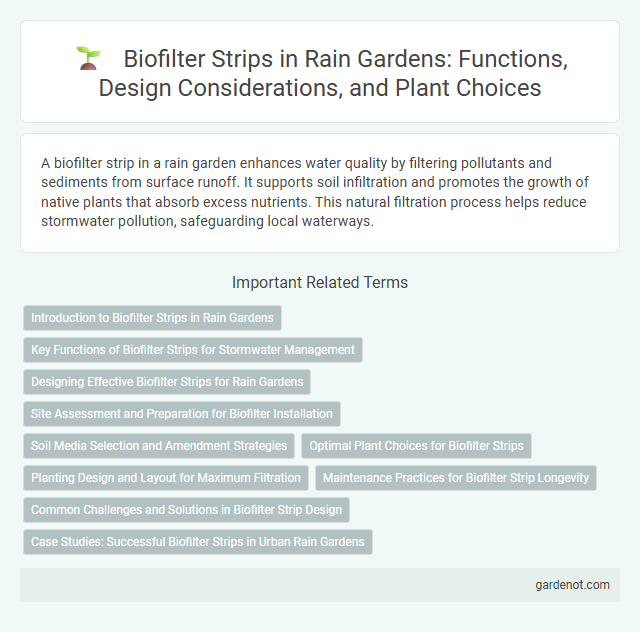A biofilter strip in a rain garden enhances water quality by filtering pollutants and sediments from surface runoff. It supports soil infiltration and promotes the growth of native plants that absorb excess nutrients. This natural filtration process helps reduce stormwater pollution, safeguarding local waterways.
Introduction to Biofilter Strips in Rain Gardens
Biofilter strips are vegetated areas designed to capture and treat stormwater runoff by filtering pollutants through soil and plant roots. These strips play a crucial role in rain gardens by enhancing water infiltration, reducing surface runoff, and improving water quality through natural biological processes. Incorporating native plants with deep root systems optimizes pollutant removal and supports ecosystem health in urban stormwater management.
Key Functions of Biofilter Strips for Stormwater Management
Biofilter strips effectively reduce stormwater runoff by filtering pollutants such as sediments, nutrients, and heavy metals through vegetation and soil layers. These strips enhance infiltration, promoting groundwater recharge and mitigating surface flooding. Their strategic placement along impervious surfaces optimizes capture and treatment of stormwater, improving water quality in urban environments.
Designing Effective Biofilter Strips for Rain Gardens
Designing effective biofilter strips for rain gardens requires selecting native plants with deep root systems to enhance soil permeability and pollutant uptake. Incorporating layers of sand, organic compost, and gravel maximizes water infiltration and filtration capacity while preventing soil compaction. Positioning the biofilter strip to capture runoff from impervious surfaces optimizes nutrient removal and reduces stormwater pollution.
Site Assessment and Preparation for Biofilter Installation
Site assessment for biofilter strip installation involves analyzing soil permeability, slope gradient, and existing vegetation to ensure optimal water absorption and pollutant filtration. Preparing the site includes removing invasive species, grading the area to promote proper drainage, and amending soil with organic matter to enhance microbial activity. Accurate site evaluation and preparation are crucial for maximizing the biofilter's effectiveness in capturing runoff and improving water quality.
Soil Media Selection and Amendment Strategies
Soil media selection for biofilter strips in rain gardens is critical for optimizing water infiltration and pollutant removal, favoring a mix of sandy loam with high organic matter content to enhance permeability and microbial activity. Amendment strategies often include incorporating compost or biochar to boost nutrient retention and support healthy soil structure, promoting effective filtration of stormwater contaminants such as heavy metals and nutrients. Properly engineered soil media ensures a balance between hydraulic conductivity and contaminant adsorption, ultimately improving the biofilter's performance in managing urban runoff.
Optimal Plant Choices for Biofilter Strips
Optimal plant choices for biofilter strips in rain gardens include native grasses, sedges, and wildflowers that tolerate periodic flooding and drought conditions. Species such as Carex stricta, Juncus effusus, and Echinacea purpurea enhance pollutant filtration while providing habitat for beneficial insects. Selecting deep-rooted plants improves soil stabilization and maximizes nutrient uptake, increasing the biofilter strip's effectiveness in stormwater management.
Planting Design and Layout for Maximum Filtration
Biofilter strips in rain garden planting design utilize a strategic arrangement of native grasses, sedges, and moisture-tolerant plants to maximize pollutant filtration and water absorption. Layering deep-rooted species like switchgrass with shallow-rooted sedges enhances soil permeability and microbial activity, accelerating the breakdown of contaminants. Optimizing plant density and diversity within the biofilter strip improves sediment capture and nutrient uptake, leading to efficient stormwater treatment and groundwater recharge.
Maintenance Practices for Biofilter Strip Longevity
Regular inspection and removal of accumulated debris in biofilter strips enhance water flow and prevent clogging. Seasonal pruning of vegetation maintains plant health and supports pollutant uptake, ensuring sustained filtration efficiency. Periodic soil testing guides nutrient management and informs necessary amendments to preserve soil structure and microbial activity critical to biofilter strip longevity.
Common Challenges and Solutions in Biofilter Strip Design
Biofilter strips commonly face challenges such as soil compaction, inadequate vegetation establishment, and poor water infiltration, which reduce their effectiveness in stormwater management. Solutions include selecting deep-rooted native plants that enhance soil structure, incorporating engineered soil media with high permeability, and designing appropriate slope gradients to prevent erosion and ensure uniform water flow. Regular maintenance practices, like sediment removal and mulching, support long-term functionality and pollutant removal efficiency in biofilter strips.
Case Studies: Successful Biofilter Strips in Urban Rain Gardens
Case studies of successful biofilter strips in urban rain gardens highlight their efficiency in reducing stormwater runoff and improving water quality through natural filtration processes. Projects in cities like Portland, Seattle, and Melbourne demonstrate how biofilter strips effectively remove pollutants like heavy metals, nitrogen, and phosphorus while supporting urban biodiversity. These implementations show enhanced infiltration rates and reduced flooding risks, proving biofilter strips as critical infrastructure in sustainable urban water management.
Biofilter strip Infographic

 gardenot.com
gardenot.com